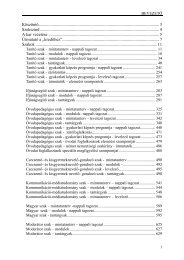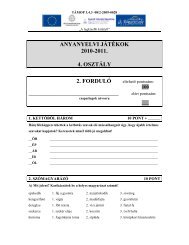ACTA SZEKSZARDIENSIUM - Pécsi Tudományegyetem Illyés Gyula ...
ACTA SZEKSZARDIENSIUM - Pécsi Tudományegyetem Illyés Gyula ...
ACTA SZEKSZARDIENSIUM - Pécsi Tudományegyetem Illyés Gyula ...
Create successful ePaper yourself
Turn your PDF publications into a flip-book with our unique Google optimized e-Paper software.
Wine routes in the south transdanubian tourism region<br />
4.4. The Mohács-Bóly white wine route<br />
The Mohács-Bóly white wine route is a thematic wine route which is- indicated by its name<br />
also- specialized on white wines and their connected events with the location concentrating<br />
on the Versend district within the Pécs wine district (SZABÓ, G. 2001, 2002, 2003, MÁTÉ, A.<br />
2007a, 2009). Out of the 33 settlements of the wine district 11 settlements of the wine district<br />
and one settlement out of the wine district have wine route service providers. The number<br />
of the service providers of the settlements significantly grew in the latter years. The most of<br />
the suppliers are situated in the central settlement of the wine route – Bóly – with 25% of the<br />
total suppliers. Mohács possesses of 18% of the suppliers. The wine producers could<br />
not achieve any significant national results, however the wine route is really peculiar<br />
due to its multiethnic variegation (Serbian, Croatian, German) and their connected<br />
folk traditions and events. Due to the former producing traditions cellar villages<br />
were maintained here as well (Máriakéménd, Szederkény, Bóly, Nagynyárád), which<br />
wine tourism utilisation partly has begun. The familiarity of the wine route could be<br />
strengthened by that the „Busójárás” of Mohács has been enrolled on the representative list<br />
of the UNESCO cultural heritage in 2009.<br />
4.5. The Pécs-Mecsek wine route<br />
The Pécs-Mecsek wine route was established in 2005 encompassing the Pécs and Szigetvár<br />
districts of the Pécs wine district. The first qualifications were carried out in the wine route<br />
in 2007, so the least suppliers are found in this wine route. In its complementary services the<br />
German ethnic culture and the long lasting tradition of village tourism could be an important<br />
element in the future. Apparently Pécs and Mecseknádasd are the most significant settlements<br />
of the wine route. Pécs as the Cultural Capital of Europe in 2010 advanced the popularization<br />
of the wine route, however, concerning the façade of the city the role of the wine is hardly<br />
reflected. The actuation of the wine route needs further developments.<br />
5. Elements of the wine route cooperation<br />
Family undertakings provide the services. The municipality facilitates the establishment of<br />
the infrastructure background and backs the undertakings through local decrees. Communal<br />
marketing is to be formed by the municipalities, undertakings and the wine-growing<br />
communities. The associations may be in work relation with other exterior organizations<br />
though the majority of the connections are characterized by a two-way information flow:<br />
● Authorities, supervisory bodies, unions (Ministry of Agriculture and Regional<br />
Development, National Public Health Authority, National Custom and Finance<br />
Headquarters, Institute for Consumer Protection, National Council of Vineyard<br />
Communities, etc.)<br />
67




